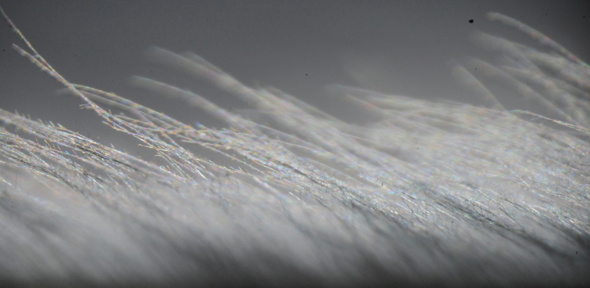News Release from windfair.net
Wind Industry Profile of
Silent flights: How owls could help make wind turbines and planes quieter
An investigation into how owls fly and hunt in silence has enabled researchers to develop a prototype coating for wind turbine blades that could significantly reduce the amount of noise they make.
Early tests of the material, which mimics the intricate structure of an owl’s wing, have demonstrated that it could significantly reduce the amount of noise produced by wind turbines and other types of fan blades, such as those in computers or planes. Since wind turbines are heavily braked in order to minimise noise, the addition of this new surface would mean that they could be run at much higher speeds – producing more energy while making less noise. For an average-sized wind farm, this could mean several additional megawatts worth of electricity.
The surface has been developed by researchers at the University of Cambridge, in collaboration with researchers at three institutions in the USA. Their results will be presented today (22 June) at the American Institute of Aeronautics and Astronautics (AIAA) Aeroacoustics Conference in Dallas.
“Many owls – primarily large owls like barn owls or great grey owls – can hunt by stealth, swooping down and capturing their prey undetected,” said Professor Nigel Peake of Cambridge’s Department of Applied Mathematics and Theoretical Physics, who led the research. “While we’ve known this for centuries, what hasn’t been known is how or why owls are able to fly in silence.”
Peake and his collaborators at Virginia Tech, Lehigh and Florida Atlantic Universities used high resolution microscopy to examine owl feathers in fine detail. They observed that the flight feathers on an owl’s wing have a downy covering, which resembles a forest canopy when viewed from above. In addition to this fluffy canopy, owl wings also have a flexible comb of evenly-spaced bristles along their leading edge, and a porous and elastic fringe on the trailing edge.
“No other bird has this sort of intricate wing structure,” said Peake. “Much of the noise caused by a wing – whether it’s attached to a bird, a plane or a fan – originates at the trailing edge where the air passing over the wing surface is turbulent. The structure of an owl’s wing serves to reduce noise by smoothing the passage of air as it passes over the wing – scattering the sound so their prey can’t hear them coming.”

Close-up view of a flight feather of a Great Grey Owl. Credit: J. Jaworski.
In order to replicate the structure, the researchers looked to design a covering that would ‘scatter’ the sound generated by a turbine blade in the same way. Early experiments included covering a blade with material similar to that used for wedding veils, which despite its open structure, reduced the roughness of the underlying surface, lowering surface noise by as much as 30dB.
While the ‘wedding veil’ worked remarkably well, it is not suitable to apply to a wind turbine or aeroplane. Using a similar design, the researchers then developed a prototype material made of 3D-printed plastic and tested it on a full-sized segment of a wind turbine blade. In wind tunnel tests, the treatment reduced the noise generated by a wind turbine blade by 10dB, without any appreciable impact on aerodynamics.
While the coating still needs to be optimised, and incorporating it onto an aeroplane would be far more complicated than a wind turbine, it could be used on a range of different types of wings and blades. The next step is to test the coating on a functioning wind turbine. According to the researchers, a significant reduction in the noise generated by a wind turbine could allow them to be spun faster without any additional noise, which for an average-sized wind farm, could mean several additional megawatts worth of electricity.
The research was funded by the US National Science Foundation and the US Office of Naval Research.
- Source:
- University of Cambridge
- Link:
- www.cam.ac.uk/...
